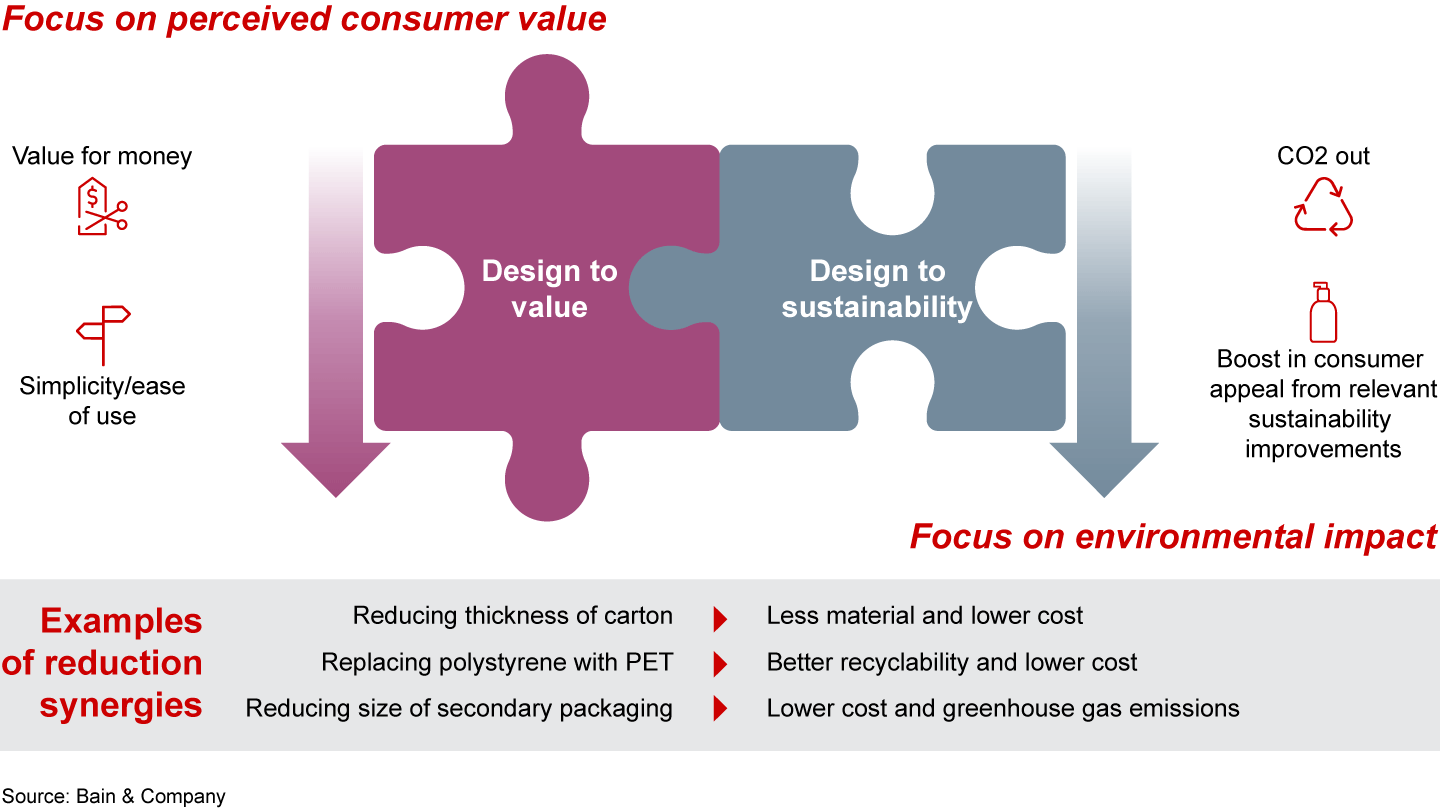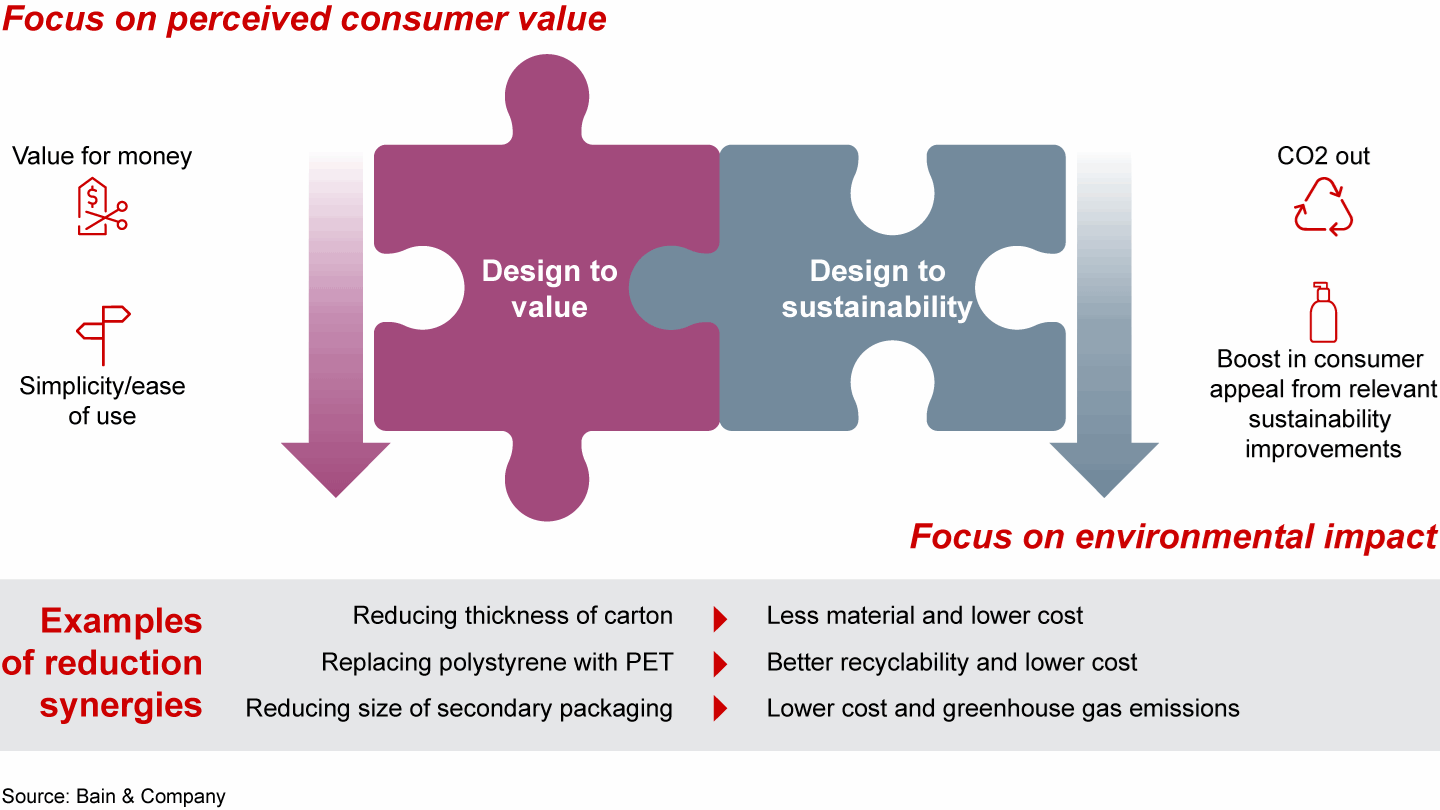Brief

한눈에 보기
- Consumer goods companies regaining their footing in the current downturn are reevaluating product portfolios for opportunities to redesign products and take out costs.
- By using a design-to-X approach that considers sustainability as a design factor, some are finding they can cut costs while also making their products more sustainable.
- Companies can use a cross-functional Agile approach to identify and execute promising ideas that can be rolled out in as soon as six months, improving cost efficiency and creating sustainable products that have more consumer appeal.
What seemed unachievable is now a no-brainer.
Many consumer goods companies struggling to meet sustainability goals assume that adapting product formulations or packaging to generate lower carbon emissions or produce less potential waste means boosting costs with expensive new materials and production processes that eat into margins. Now, some are finding the opposite is true: By making their products more sustainable, they are able to cut costs—sometimes significantly—even as they create products that have more consumer appeal. Consider it a positive consequence of the Covid-19 pandemic. As companies strive to regain footing in the downturn, they quickly are reevaluating product portfolios. Many are looking for opportunities to take costs out while adding value. Companies achieve both by using an approach called design-to-X (D2X), in which the X factor is anything the consumer values that has an impact on design. By making sustainability an X factor, some companies are finding better answers than they anticipated, and a way to help them emerge from the crisis stronger (see Figure 1).
Contrary to popular belief, in a design-to-X process companies can optimize for both cost reduction and sustainability improvement simultaneously


They are learning, for example, that eliminating just one gram of PVC in a product can lead to measurable savings and a nearly 3.4 gram reduction in fossil fuels. No large company can afford to ignore sustainability. So while they may choose to optimize for something else, sustainability should be a “must consider” variable in their decisions.

Macro Surveillance Platform
For more detail on the business implications of coronavirus from Bain’s Macro Trends Group, log on to the Macro Surveillance Platform. Learn more about the platform >
A range of consumer goods companies across product categories have reduced procurement spending and improved their environmental footprint through changes that could be rolled out in as soon as six months. For example, packaging harmonization saved one company as much as 11% on costs while substantially lowering materials requirements. Some companies have moved to such options as 3-D printing to eliminate scrapping costs, also allowing them more quickly to change label messaging for marketing promotion.
These and other changes help companies improve costs at a time when they need cash to help them grow out of the downturn. It also enables companies to benefit from consumers’ embrace of sustainability. US sales of products marketed as sustainable grew 5.6 times faster than other products from 2013 to 2018, according to the NYU Stern Center for Sustainable Business.
When companies use sustainability as one of the key X factors in design, they typically take a four-step approach.
Set the rules. Companies need to clarify their ambition, their cost reduction and their margin improvement targets—while also determining the sub-X factors; that is, which dimensions of sustainability are most important to the brand. They need to set guidelines on how to manage trade-offs by product category or brand. That means asking, for example, how product packaging and design are linked to what consumers really value, and how to quantify the trade-off between those values, costs and sustainability. Cost-cutting steps that also showcase a sustainability effort may signal a highly visible commitment to something that consumers value.
Get the facts. The best companies conduct a rigorous cost analysis of both existing products and newly designed products. Alongside such considerations as detailed material costs and capex requirements, they assign a sustainability score to each product, looking at such factors as emissions and recyclability. The fact base covers all of the four Rs of sustainability: reducing unnecessary materials as much as possible; creating product packaging that is reusable; finding ways to replace existing materials with more sustainable materials; and ensuring products can be recycled. They also take a “shelf back” and “factory forward” approach to find the middle ground between consumer needs and cost efficiency. That involves designing the product assortment to win at the point of sale—and eliminating complexity by focusing on best-selling “hero” SKUs, for example. At the same time, it requires engineering the products for a sustainable cost advantage. Many efforts fail when there is a lack of close collaboration and agreement between supply- and operations-focused teams and the consumer-oriented marketing teams.
Speed the process. The benefits of Agile execution are well documented. When properly conducted, Agile ways of working reduce project delivery times from 18–24 months to 5–6 months. Companies attribute rapid results in large part to empowered, cross-functional Agile teams and effective governance based on a set of specific operating principles. Among those principles: design targets that are co-owned by marketing, supply chain, procurement and sustainability, with a senior, cross-functional review board empowered to approve projects in order to hit targets. Also important: The review board has sole and final decision authority to approve ideas from the design sprints.
Make it stick. As with any performance improvement initiative, it is essential to rigorously track results to both fully capture savings and ensure those savings stick. The most successful companies will use their learnings to make sustainability part of their new product development process. Generating the most value from the effort also means capitalizing on sustainability gains for stronger branding and a cultural shift. The best companies embed sustainability in marketing and branding by celebrating and communicating the sustainability benefits to employees, customers and consumers.
Even before Covid-19 began taking its toll, forward-thinking companies started reaping the rewards of taking sustainability seriously—and marketing those efforts. Brands tied to Danone’s “One Planet. One Health” corporate-level manifesto grow three times faster than the rest of the company’s portfolio. Unilever’s 28 sustainable living brands are growing 69% faster than its other brands and are the engine powering 75% of the company’s growth.
The reality is that companies don’t need to choose between cutting costs and meeting the growing demands by consumers, retailers and regulators for sustainable products. It’s possible to optimize for both and come out stronger in a post-Covid world.

Coronavirus
The global Covid-19 pandemic has extracted a terrible human toll and spurred sweeping changes in the world economy. Across industries, executives have begun reassessing their strategies and repositioning their companies to thrive now and in the world beyond coronavirus.